|
Africa
2024 Journal Pages:
1
2
3
4
5
6
7
8
9
10
11
12
January
8 - continued
There
were animals everywhere. We were able to get quite close to a
giraffe standing under an acacia tree. Zebras were scattered
across the plain, and a small herd hung out at a waterhole.
Several tsessebes grazed nearby; these distinctive dark-brown
antelope are much higher at the shoulder than the hindquarter.
They are the fastest of the antelopes.
A male ostrich was walking among the sparse trees, his
black and white plumage standing out vividly against the grey
trunks of the dead trees. The ostriches are bigger than you would
think, and always seem sort of comical to me. A bit further on we
saw three female ostriches; they are a more drab greyish brown
color, and much better camouflaged than their flamboyant mates.
We came upon several beautiful female kudus. These large
antelopes are exquisite; they have intelligent faces, huge ears,
thin white stripes on their sides, and a scruffy mane all the way
down their backs. The males have huge spiraling horns, but these
were all girls.
We found another group of giraffes; these had several
youngsters and one quite small baby - there are few things cuter
than a baby giraffe. We
saw some very young impala babies as well, and they gazed as us
with innocent faces. Two warthogs came up out of a wallow; they
were covered in wet mud, and looked ridiculous as they ran off
with their tails held straight up in the air. We saw more
elephants, again all males.
There were many birds of prey out this morning. Gee pointed
out a handsome bird and told us it was a brown snake eagle. Janell
asked, “Is that because it only eats brown snakes?” We also
saw a steppe buzzard, a lovely chestnut color.
‘Buffalo,’
Gee called out, and we stopped to watch a small herd of half a
dozen African buffalo. It was a bachelor herd, all males. The
dominant bull had an impressive set of thick horns, known as a boss. He stared at us suspiciously with near-sighted eyes, raising
his head and sniffing the air with an ill-tempered expression.
Gee pointed out that there were both red-billed and
yellow-billed oxpeckers on the buffalo. These birds ride on many
of the large animals, picking off ticks and bugs, but also picking
at scabs and sores. They can perform a good symbiotic service, but
can also be a huge annoyance. You see them on animals such as
buffalo, giraffes, kudus and zebras. They don’t seem to bother
the elephants, I expect because the elephants could use their
trunks to get rid of them.
We came across more zebras at a waterhole; I never get
tired of watching these roly-poly cousins to the horse. Each one
has unique patterns to their stripes, like fingerprints. Up
close their bold black and white stripes are dazzling, but from a
distance they appear grey and blend into the background.
As well as seeing the large animals, we enjoyed the small
things. Gee showed us a column of harvester termites, cutting
sections of grass and leaves and carrying them down into a hole.
This type of termite does not build mounds, but lives underground.
Gee is fantastic at reading tracks in the sand along the
roads; he could see a print and not only know what animal made it,
but also tell you exactly what it was doing. Looking at some
elephant footprints, Gee explained that the elephant that had made
it was on the young side, because you could see a lot of tread in
his tracks; their feet get smoother as they age. He showed us an
interesting row of diagonal tracks in the sand, and told us they
were made by a sleepy elephant that had walked along the road with
his trunk swishing back and forth as it dragged the ground.
There were aardvark hole everywhere; these burrows are
large and deep. They are often taken over by other animals such as
warthogs or hyenas. It is interesting that we see so many aardvark
holes but never see the aardvark; Gee told us they are not that
rare, but are rarely seen because they are shy and nocturnal. We
stopped to examine one of their burrows that had been dug out
around the entrance. Gee read the tracks; warthogs had taken over
the hole, and lions had been digging trying to get to them.
|
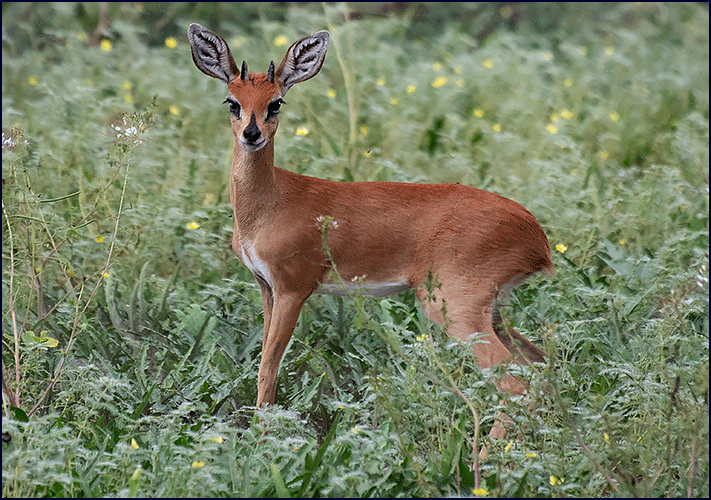
Steenbok
|
A pair of steenboks stood in the shade not far from the
road. These miniscule antelope are exquisite; they have dainty
faces, and the males sport tiny straight horns. They tend to be
quite shy, and these leaped away and disappeared into the brush as
we approached.
The remains of a dead elephant carcass lay near the road.
Gee paused for us to look, but the smell was pretty bad. The grey
skin looked like a collapsed tent, and part of a foot lay right by
the road. We wondered what had killed it.
Around noon we passed an old derelict camp, and came out of
the trees to a big lagoon, which was actually part of the Gometi
River. A small herd of elephants lingered near the shore. We saw a huge variety of waterfowl. Marabou storks stood
along the shore; these unique birds are very large and impossibly
ugly. They have bald heads with a few sparse hair-like feathers,
unhealthy-looking mottled skin, beady little eyes you can hardly
see, and large, fleshy obscene-looking snoods that hang down in
from their necks. They are so unattractive that it is fascinating
to see them in a morbid sort of way, kind of like watching a train
wreck.
|
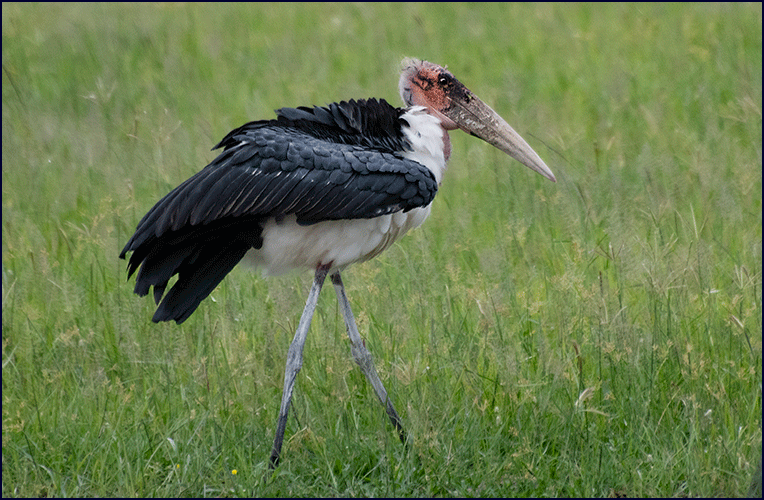
Marabou Stork |
We decided to count all the birds we could see from one
spot. There were Egyptian geese, spur-winged geese, white-faced
ducks and comb ducks in the water. Roseate
spoonbills waded near the shore, using their shovel-like bills to
hoover for food. Diminutive red-billed tea paddled in the
shallows, along with Hottentot teal with their bright blue bills.
We could see jacanas, blacksmith lapwings, ruffs, three-banded
plover, black-winged stilts and wood sandpipers. There was a
glossy ibis, several small grebes, and a collared pratincole. A
yellow-billed kite perched in a tree. A common scimitar bird flew
across in front of us. That came to twenty different birds without
even moving, and I am sure I missed a few in that count.
|
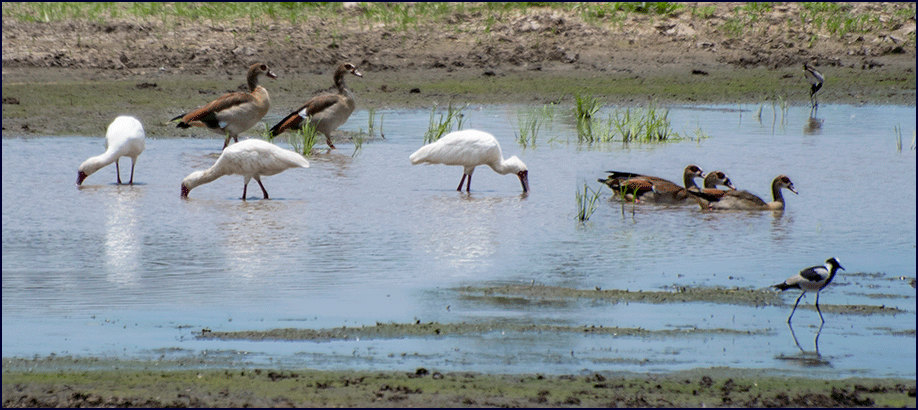
Egyptian geese, spoonbills and blacksmith lapwings - just
a few of the birds at the lagoon.
|
We heard a commotion, and a female elephant came into view,
the first we had seen. She was moving fast, and seven males were
all in a row running behind. Gee said they were probably all in
musth, a periodic breeding condition in male elephants
characterized by a large rise in reproductive hormones and
testosterone, and aggressive behavior. He explained that when a
female elephant is in estrus, she will run for miles and the males
will chase her; she will ultimately mate with the one who can go
the furthest and keep up with her. This is the elephant’s way of
determining who the strongest potential mate is without fighting.
We marveled at the number of animals we were seeing at
Kaziikini. Gee said that the rainy season is the best time to
visit, because there are waterholes everywhere, and many of the
animals leave the Okavango Delta and come to this area. During the
dry season the waterholes dry up and the wildlife goes back to the
Delta, but for now we were seeing an abundance of animals. They
all seemed to be in good condition, well fed and plump. During the
rainy season there is much grass so all the grazers are well fed,
and this makes for good meals for the predators as well.
Moving on, we crossed through an expanse of dead trees,
then entered a denser woodland. Here we found a family of kudus; a
mother with a young baby. There was also a half-grown male with
small horns. We had seen several female kudus today, but I was
hoping to see a mature male, as they have the most magnificent
spiral-twisted horns. But we were very excited to see the baby!
|
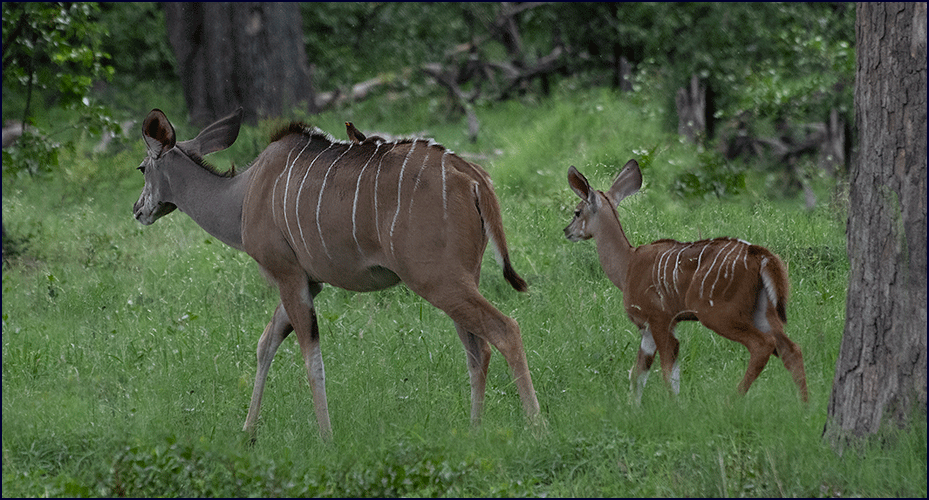
Kudu mom and baby |
We
passed another elephant carcass; I really wondered what had killed
it. Not poachers, as the tusks were still there. A bit further on
there were the bones and hide of yet another dead elephant. I
found it a disturbing sight.
Presently we came back to the same waterhole where we had
tea in the morning, this time approaching from the opposite side.
The sun had briefly come out from behind the clouds. A
yellow-billed hornbill watched us from a high branch; I think
these are more photogenic than their more common red-billed
cousins.
A male elephant made his way down to the water to drink
with a family of warthogs following in his wake. A few zebras and
kudus wandered toward the water, and we watched a baby zebra
scratching his rump on a tree. Three large bull elephants stood at
the edge of the waterhole having a drink, sucking up large amounts
of water with their trunks then thrusting them into their mouths.
We noticed that one male
elephant was in a bad mood - he clearly didn’t want us there. As
we sat in the land cruiser watching the herd, he walked by us
feigning indifference while keeping a wary eye on us. But he
gradually started to walk faster, and he became more and more
agitated, turning his head toward us and flapping his ears. Then
suddenly the elephant turned and charged straight at us! He
wasn’t very far away, either. With a yelp, Janell, who had been
sitting beside me, was suddenly in my lap. Of course Gee had been
watching the angry elephant and reading his mood, so he wasted no
time in accelerating out of his path. Glad we weren’t
self-driving!
As we travelled along a shallow river valley, dozens of
smallish grey raptors flew all around us; they were Amur falcons.
They seemed to by flying joyfully, riding the wind, embodying
freedom. We saw more
birds; helmeted guinea fowl crossed our path frequently, and Gee
identified pied babblers from hearing their song while driving –
another of his impressive guiding skills. We watched as a bateleur
eagle soared overhead, his outstretched wingtips moving as he
navigated the breeze.
We came across yet another elephant carcass, this was the
fourth one we had seen, and this time Gee stopped and we got out
to take a look. It was pretty well rotted, mostly hide and bones.
We didn’t know what had killed these elephants; Gee said maybe
anthrax. Definitely not poachers, as they would have taken the
tusks. Though there is horrible poaching in much of Africa, there
is relatively little of it in Botswana, as the army acts as an
anti-poaching unit and has instructions to shoot to kill. Gee held
up one of the tusks for a photo, and said he would report the
carcass to the reserve owners so the rangers could retrieve the
tusks. Paula plucked some hairs tails from the dead tail, and said
“Look, I’m a Level 3 Guide!” We did a cheesy group photo
beside the carcass.
It had been cloudy all day, though the sun would come out
for a few minutes here and there. In the afternoon we could see
dark storm clouds gathering around the horizon, and the slanting
silver of rain falling. We
saw vivid lightning split the sky, but oddly we could not hear any
thunder. Sometimes the storms were in the distance, and other
times they overtook us with a sudden deluge. This was a pattern
that continued for the first 12 days of our trip!
We turned into the road to our camp, and paused at the
Kaziikini camp office. There was an empty building with a sign
that said ‘Bar’, with a porch deck overlooking a waterhole.
The bar was totally deserted, but to our delight a breeding herd
of female elephants with their babies were walking along the bank
of the waterhole. There were over a dozen of them, mothers with
young ones, and several of the babies were quite tiny. These were
the first female elephants we had seen all day, except of course
the one being chased by the seven randy males.
It was starting to rain hard as we arrived back in camp
around four o’clock for a late lunch. We were elated at the
fabulous day we’d had. Gee went to the reserve office and called
to see if my suitcase had arrived in Maun; it had not, but we were
told it had reached Johannesburg, and supposedly would come to
Maun the next day. I could only hope Duma (the stuffed cheetah
mascot) was not too scared.
We noticed a red-billed hornbill in the tree above the
dining table. Gee explained that the female hornbill will find a
crevice inside a hollow tree, then molt her feathers and use them
to make a nest for her eggs. The male will seal her up inside the
tree and feed her through a small opening until the eggs hatch,
the babies grow big enough to fly and the mother grows her
feathers back. We
watched the father hornbill as he inserted food for his mate
through the narrow opening in the trunk.
We went back out around 5.25 for a short evening game
drive. We passed through one of the many forests of dead trees,
which had been decimated by elephants. It was a good evening for
birds. A little bee-eater, one of my favorite birds, was sitting
on a branch with a butterfly in his mouth. He would perch in a
tree for the longest time, then suddenly fly off quick as a flash,
grab an insect, and return to the same twig. These beautiful birds
have green backs, yellow bellies, a black stripe across their
faces, and brilliant turquoise above their eyes, as if they put on
iridescent eye shadow.
|
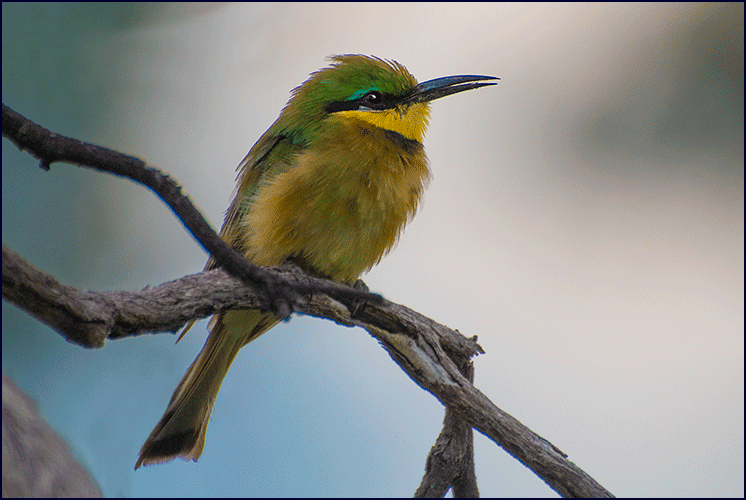
Little bee-eater |
We passed a red-billed buffalo weaver nest; these
industrious birds build a large communal nest. Gee sighted a
European bee-eater; I was scanning but couldn’t quite locate it.
‘There,’ said Paula, ‘it’s in that dead tree.’ We
pointed out to her that this wasn’t very helpful, as there were
about a hundred dead trees in front of us! We got a good look at a
pair of swallow-tail bee-eaters. They are less common than the
little bee-eaters, and have a forked tail like a swallow, which is
a beautiful shade of turquoise blue.
We
saw a few scattered elephants and zebras, and always impala. It
was starting to rain again, so we headed back to camp. Having had
little sleep the night before, I was nodding off as we drove back
through the darkening evening.
Mosa
had fixed us a delicious dinner of beef tenderloin and fresh
veggies. We sat around the table, had some wine, and talked about
the awesome day we had. We had seen an amazing array of wildlife,
especially overwhelming for those in the group who had not been on
safari before. No cats or major predators, but we had seen just
about everything else. We reviewed our favorite sightings of the
day; it was difficult to choose. My choice was the angry elephant
who charged us - but then again, those young giraffes play
fighting and hitting each other with their necks had been pretty
special . . .
There was no campfire that evening since it was raining. I
went to bed as soon as dinner was over, and slept like a log. No
animal noises in the night this time - or if there were, I never
heard them.
~
Continued
on next page ~
Africa
2024 Pages:
1
2
3
4
5
6
7
8
9
10
11
12
Back
to the AFRICA 2024 INDEX Page
|